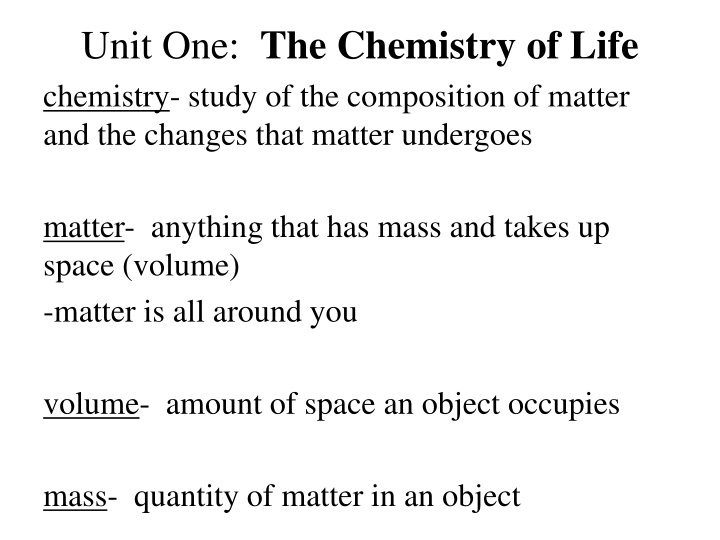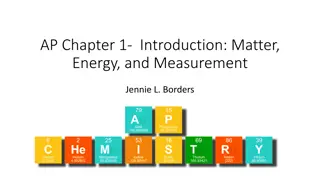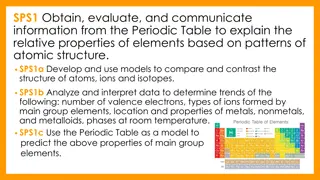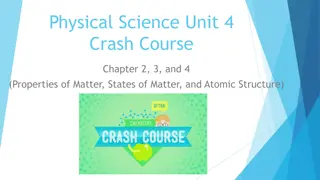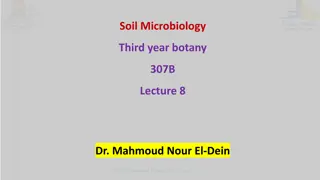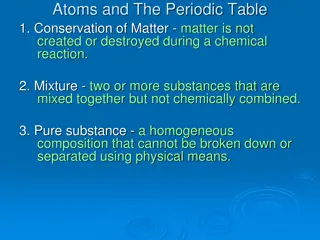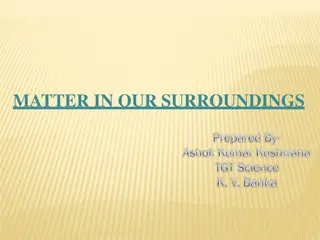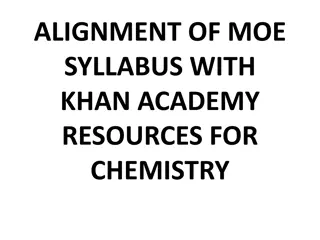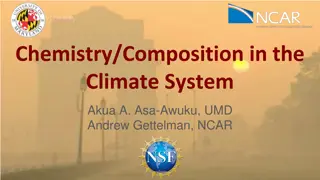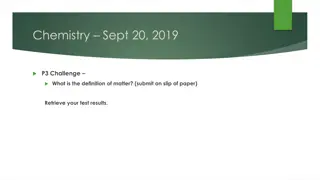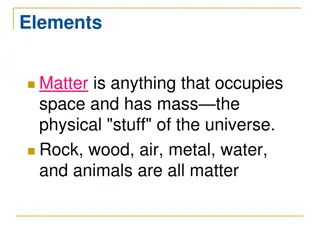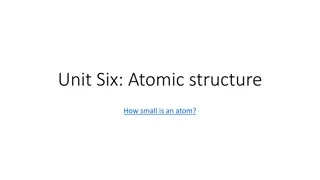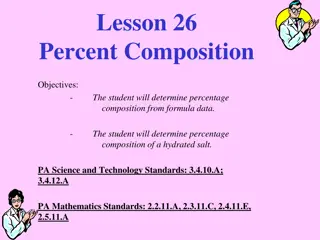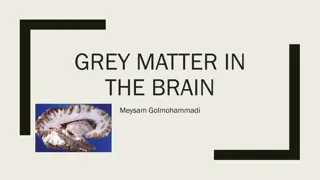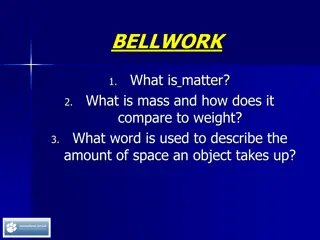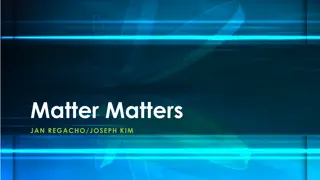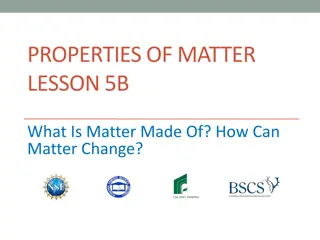Chemistry of Matter: Composition and Changes
The study of matter involves understanding its composition and the various changes it can undergo, from physical alterations to irreversible chemical transformations. Exploring the phases/states of matter, elements, atoms, and subatomic particles provides insights into the fundamental building blocks of everything around us. Protons, neutrons, and electrons form the structure of atoms, while the balance of positive protons and negative electrons determines the electrical neutrality of an atom. Delve into the world of chemistry to unravel the secrets of matter and its behavior.
Download Presentation

Please find below an Image/Link to download the presentation.
The content on the website is provided AS IS for your information and personal use only. It may not be sold, licensed, or shared on other websites without obtaining consent from the author.If you encounter any issues during the download, it is possible that the publisher has removed the file from their server.
You are allowed to download the files provided on this website for personal or commercial use, subject to the condition that they are used lawfully. All files are the property of their respective owners.
The content on the website is provided AS IS for your information and personal use only. It may not be sold, licensed, or shared on other websites without obtaining consent from the author.
E N D
Presentation Transcript
Unit One: The Chemistry of Life chemistry- study of the composition of matter and the changes that matter undergoes matter- anything that has mass and takes up space (volume) -matter is all around you volume- amount of space an object occupies mass- quantity of matter in an object
Phases/States of Matter -solids -liquids -gases -matter can undergo changes physical change- alters a given material without changing its composition -described by words like cutting, grinding, bending -are reversible ex- carving wood, melting ice, stretching rubber band
chemical change- results in a change in chemical composition of a substance -change is not reversible -described by words like burn, rot, rust, explode ex- wood burning, iron left out in the rain
element- pure substance, one type of atom Ex: hydrogen, carbon, oxygen, sodium -all found on the periodic table -represented by chemical symbols; H, C, O, Na
atom basic unit of all matter -extremely small -comes from Greek word atomos- unable to cut -made up of three subatomic particles: protons, neutrons, and electrons
**protons and neutrons have the same mass -both found in the nucleus- center of the atom protons (p+) have a + charge neutrons (n0) have no charge, neutral
-electrons are much smaller -found orbiting the nucleus in energy levels or electron clouds and are attracted to p+ electrons (e-) carry a - charge
** # of p+= # of e-in an atom making it electrically neutral
*REMEMBER* # of p+= # of e-in an atom atomic number- number of protons in the nucleus of an atom (smaller number on the periodic table) -also = # of electrons b/c of above * -specific to each element
mass number- total number of protons and neutrons in an atom -larger number on periodic table -must be rounded to a whole number # of n0 = mass # - atomic # -element can be written as He-4 *atomic # never changes, but mass # can
Ex: How many p+, e-and n0in each? 1) calcium p+ = 20 e-= 20 n0 = 20 2) chlorine p+ = 17 e-= 17 n0 = 18 3) p+ = 28 e-= 28 nickel n0 = 31
isotope- atoms of the same element having the same # of p+and e-, but different # of n0 ex- Ne-20 10p+10e-10n0 Ne-21 10p+10e-11n0 Ne-22 10p+10e-12n0
Isotopes of carbon 6 electrons 6 protons 6 neutrons 6 electrons 6 protons 7 neutrons 6 electrons 6 protons 8 neutrons
radioactive isotopes- have unstable nuclei that break down over time -radiation can be dangerous -can also be helpful to: *determine age of rocks *treat cancer *kill bacteria that cause food to spoil *trace substances through organisms
chemical compounds- formed by the chemical composition of two or more elements in definite proportions -represented by: chemical formula- shows the kinds and number of each element in a compound ex- H2O CO2 H3PO4
chemical bonds- what holds compounds together *valence electrons (e- in outermost energy level) are involved in bonding -bonds can be ionic or molecular/covalent
ionic bonds- transfer of e- from one ion (atom with a charge) to another -form ionic compounds (metal + non-metal) -metal = + charged (cation) *loses e- -non-metal = - charged (anion) *gains e-
Ionic Bonding CaC 2 calcium chloride calcium = positive ion chlorine = negative ion
covalent bonds -electrons are shared between atoms *bonds (pair of e-) are represented as dashes ( ) single covalent bond- two atoms share a pair of e- ( ) double covalent bond- bond that involves two shared pairs of e- ( ) triple covalent bond- bond that involves three shared pairs of e- ( ) *covalent bonds form molecules (2 or more nonmetals)
methane CH4
Van der Waals forces- intermolecular force between molecules *not a bond so weaker than ionic and covalent bonds ex: geckos on walls
Think about this: In order for life to exist anywhere in the universe what must be present? WATER
1. Working with a partner, make a list of ten things that have water in them. 2. Exchange your list for the list of another pair of students. Did your lists contain some of the same things? Did anything on the other list surprise you? 3. Did either list contain any living things?
WATER -makes up about 60% of human body -covers of the Earth s surface -exists as a solid, liquid or gas in nature -solid water floats in liquid water because it is less dense
*water = H2O Does H2O form a covalent or ionic bond? COVALENT *sharing of e-
*Water is polar -bonding e- shared unequally between H and O -because oxygen has more p+ than H, it is likely that the shared e- are closer to the O -oxygen has negative end and H has positive end
Hydrogen Bonding -not as strong as ionic or covalent bonds -more like a force between molecules than a bond *+ end attracted to end
-many of waters properties are due to hydrogen bonding cohesion- attraction between molecules of the same substance -creates surface tension Page 41 Fig 2-8 adhesion- attraction between molecules of different substances ex: capillary action
-water is not always pure mixture- 2 or more substances physically and not chemically combined Types of mixtures with water 1. solution- uniform in composition ex: salt water solute- what is dissolved ex: salt solvent- what does the dissolving ex: water
2. suspension- water and nondissolved material ex: muddy water, blood with cells
Acids and Bases acid- any compound that produces H+ in solution ex- HC H++ C - base- any compound that produces OH- in solution (low H+) ex- NaOH Na+ + OH-
*pH scale is used to measure H+ pH = potential hydrogen -pH scale ranges from 0-14 -pH < 7 = acids -pH > 7 = bases -pH = 7 = neutral solution *more H+ *more OH- **based on scales of 10 page 43 fig 2-10
buffers- weak acids or bases that resist pH changes *aid in keeping pH regulated in cells
Carbon Compounds organic chemistry- the study of compounds that contain bonds between carbon (C) atoms *C has four valence e- (e- in outermost energy level) *can form four covalent bonds *can have single, double or triple bonds *C bonds with H, O, N, P and S *C can form long chains and complex molecules
Macromolecules -giant molecules -made of many smaller molecules -formed by polymerization- large molecules are formed by joining smaller ones together monomers- smaller units polymers- larger units formed *like a puzzle
-monomers are joined together by dehydration synthesis -removes a water molecule to form a polymer
Hydrolysis- water is added to separate a polymer into its monomers
Groups of organic compounds in living things: 1. carbohydrates 2. lipids 3. nucleic acids 4. proteins
Carbohydrates *made up of C, H and O *in a 1:2:1 ratio ex- C6H12O6 *main source of energy ex- sugars and starches (long chain of sugars) *can be stored as complex sugars
monomers = monosaccharide- single sugar molecules ex- glucose, galactose and fructose polymers = polysaccharides- larger molecule formed from many monosaccharides ex- glycogen (excess stored sugar) and cellulose (found in wood)
Lipids *made up of C and H and some O *not soluble in water (do not dissolve) *store energy and form membranes monomers = glycerol and fatty acids polymer = fats, oils and waxes
Saturated vs Unsaturated Fatty Acids saturated- all single bonds which leads to maximum # of H unsaturated- at least one double bond between two carbon atoms -not loaded with H
Nucleic acids *macromolecules containing H, O, N,C and P *store and transmit hereditary or genetic info monomers = nucleotides -consists of 5-C sugar, a phosphate group and a nitrogenous base polymer = nucleic acid (DNA/RNA)
Proteins *contain C, N, H and O *have an amino group and a carboxyl group *most diverse macromolecule b/c of R-groups *regulates cell processes, control reaction rates, transport substances and fight disease monomers = amino acids polymer = protein
